University Nursing Leadership Report: Interview and Analysis
VerifiedAdded on 2023/01/03
|10
|2620
|98
Report
AI Summary
This report presents an analysis of an interview conducted with a nurse, focusing on leadership and management within a healthcare context. The report begins by differentiating between leadership and management, highlighting their distinct roles and functions. It then identifies and discusses the attitudes and characteristics of effective leaders, drawing on the interview data to illustrate these qualities. The report also examines the nurse's contributions to quality and safety in healthcare, providing specific examples of how leadership skills have influenced patient outcomes. Furthermore, it explores the interviewee's leadership style, comparing it with established leadership theories and research literature. The report concludes by summarizing the key findings and discussing the implications for fostering effective leadership in nursing, particularly the importance of transformational leadership in enhancing quality of care and patient safety. The report also includes a detailed reference list of academic sources used to support the analysis.
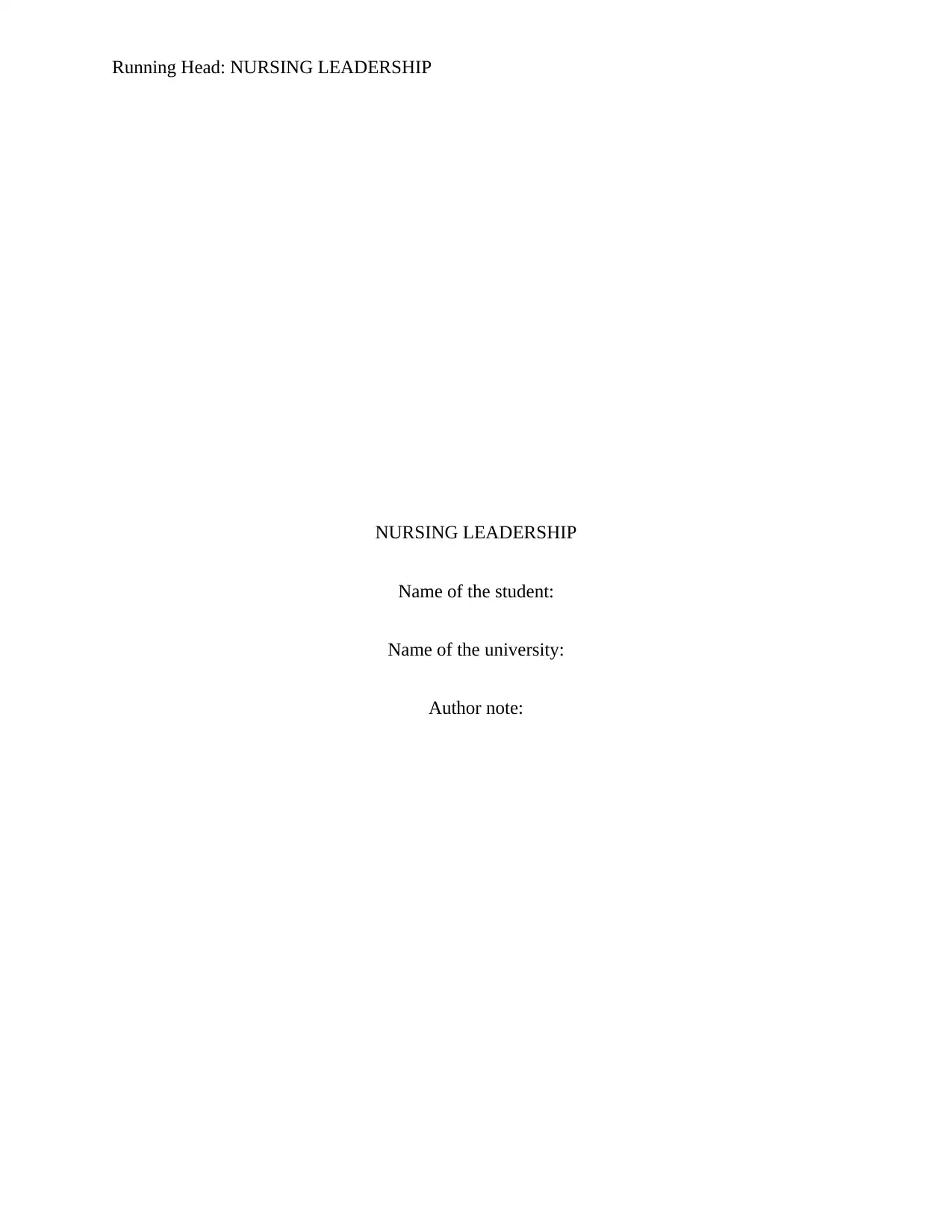
Running Head: NURSING LEADERSHIP
NURSING LEADERSHIP
Name of the student:
Name of the university:
Author note:
NURSING LEADERSHIP
Name of the student:
Name of the university:
Author note:
Paraphrase This Document
Need a fresh take? Get an instant paraphrase of this document with our AI Paraphraser
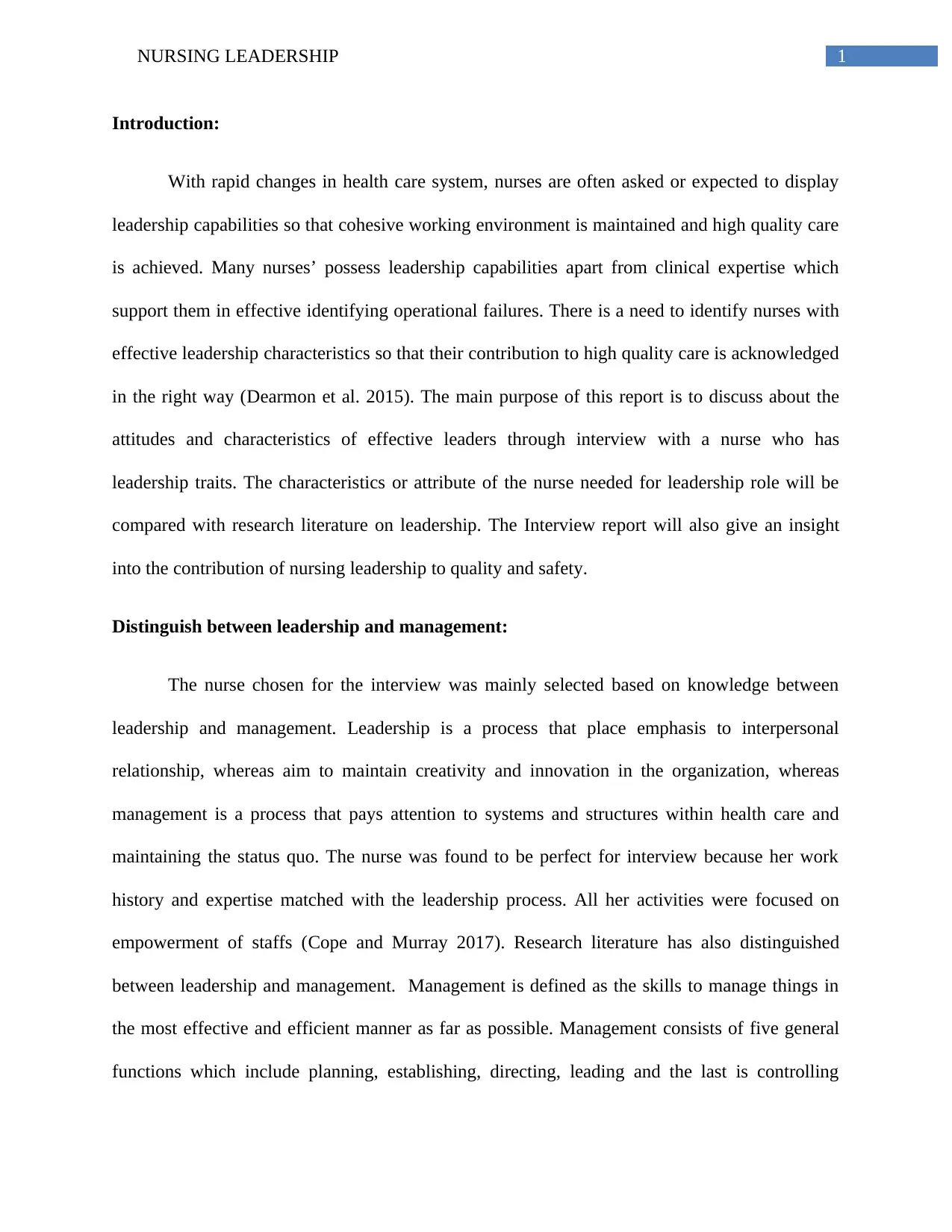
1NURSING LEADERSHIP
Introduction:
With rapid changes in health care system, nurses are often asked or expected to display
leadership capabilities so that cohesive working environment is maintained and high quality care
is achieved. Many nurses’ possess leadership capabilities apart from clinical expertise which
support them in effective identifying operational failures. There is a need to identify nurses with
effective leadership characteristics so that their contribution to high quality care is acknowledged
in the right way (Dearmon et al. 2015). The main purpose of this report is to discuss about the
attitudes and characteristics of effective leaders through interview with a nurse who has
leadership traits. The characteristics or attribute of the nurse needed for leadership role will be
compared with research literature on leadership. The Interview report will also give an insight
into the contribution of nursing leadership to quality and safety.
Distinguish between leadership and management:
The nurse chosen for the interview was mainly selected based on knowledge between
leadership and management. Leadership is a process that place emphasis to interpersonal
relationship, whereas aim to maintain creativity and innovation in the organization, whereas
management is a process that pays attention to systems and structures within health care and
maintaining the status quo. The nurse was found to be perfect for interview because her work
history and expertise matched with the leadership process. All her activities were focused on
empowerment of staffs (Cope and Murray 2017). Research literature has also distinguished
between leadership and management. Management is defined as the skills to manage things in
the most effective and efficient manner as far as possible. Management consists of five general
functions which include planning, establishing, directing, leading and the last is controlling
Introduction:
With rapid changes in health care system, nurses are often asked or expected to display
leadership capabilities so that cohesive working environment is maintained and high quality care
is achieved. Many nurses’ possess leadership capabilities apart from clinical expertise which
support them in effective identifying operational failures. There is a need to identify nurses with
effective leadership characteristics so that their contribution to high quality care is acknowledged
in the right way (Dearmon et al. 2015). The main purpose of this report is to discuss about the
attitudes and characteristics of effective leaders through interview with a nurse who has
leadership traits. The characteristics or attribute of the nurse needed for leadership role will be
compared with research literature on leadership. The Interview report will also give an insight
into the contribution of nursing leadership to quality and safety.
Distinguish between leadership and management:
The nurse chosen for the interview was mainly selected based on knowledge between
leadership and management. Leadership is a process that place emphasis to interpersonal
relationship, whereas aim to maintain creativity and innovation in the organization, whereas
management is a process that pays attention to systems and structures within health care and
maintaining the status quo. The nurse was found to be perfect for interview because her work
history and expertise matched with the leadership process. All her activities were focused on
empowerment of staffs (Cope and Murray 2017). Research literature has also distinguished
between leadership and management. Management is defined as the skills to manage things in
the most effective and efficient manner as far as possible. Management consists of five general
functions which include planning, establishing, directing, leading and the last is controlling
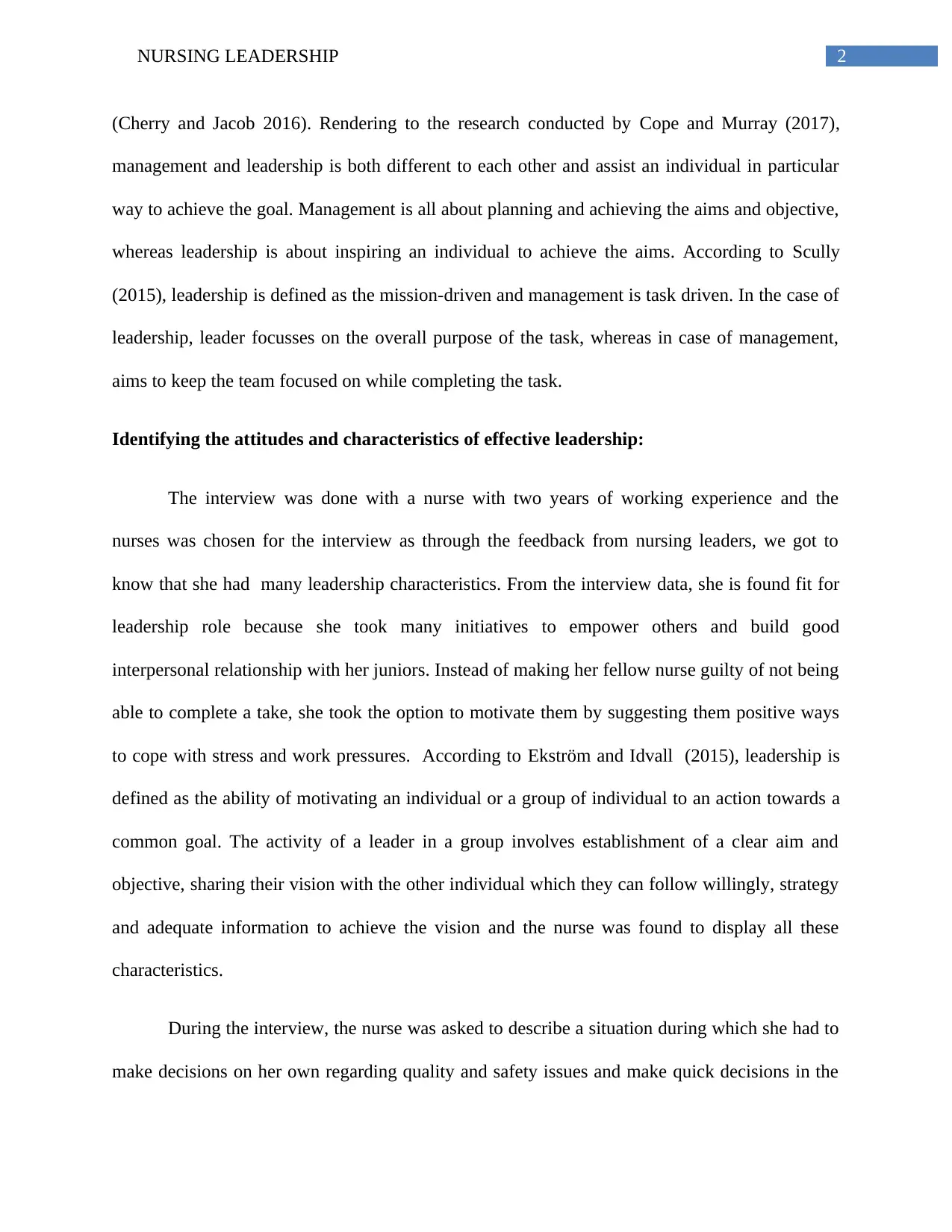
2NURSING LEADERSHIP
(Cherry and Jacob 2016). Rendering to the research conducted by Cope and Murray (2017),
management and leadership is both different to each other and assist an individual in particular
way to achieve the goal. Management is all about planning and achieving the aims and objective,
whereas leadership is about inspiring an individual to achieve the aims. According to Scully
(2015), leadership is defined as the mission-driven and management is task driven. In the case of
leadership, leader focusses on the overall purpose of the task, whereas in case of management,
aims to keep the team focused on while completing the task.
Identifying the attitudes and characteristics of effective leadership:
The interview was done with a nurse with two years of working experience and the
nurses was chosen for the interview as through the feedback from nursing leaders, we got to
know that she had many leadership characteristics. From the interview data, she is found fit for
leadership role because she took many initiatives to empower others and build good
interpersonal relationship with her juniors. Instead of making her fellow nurse guilty of not being
able to complete a take, she took the option to motivate them by suggesting them positive ways
to cope with stress and work pressures. According to Ekström and Idvall (2015), leadership is
defined as the ability of motivating an individual or a group of individual to an action towards a
common goal. The activity of a leader in a group involves establishment of a clear aim and
objective, sharing their vision with the other individual which they can follow willingly, strategy
and adequate information to achieve the vision and the nurse was found to display all these
characteristics.
During the interview, the nurse was asked to describe a situation during which she had to
make decisions on her own regarding quality and safety issues and make quick decisions in the
(Cherry and Jacob 2016). Rendering to the research conducted by Cope and Murray (2017),
management and leadership is both different to each other and assist an individual in particular
way to achieve the goal. Management is all about planning and achieving the aims and objective,
whereas leadership is about inspiring an individual to achieve the aims. According to Scully
(2015), leadership is defined as the mission-driven and management is task driven. In the case of
leadership, leader focusses on the overall purpose of the task, whereas in case of management,
aims to keep the team focused on while completing the task.
Identifying the attitudes and characteristics of effective leadership:
The interview was done with a nurse with two years of working experience and the
nurses was chosen for the interview as through the feedback from nursing leaders, we got to
know that she had many leadership characteristics. From the interview data, she is found fit for
leadership role because she took many initiatives to empower others and build good
interpersonal relationship with her juniors. Instead of making her fellow nurse guilty of not being
able to complete a take, she took the option to motivate them by suggesting them positive ways
to cope with stress and work pressures. According to Ekström and Idvall (2015), leadership is
defined as the ability of motivating an individual or a group of individual to an action towards a
common goal. The activity of a leader in a group involves establishment of a clear aim and
objective, sharing their vision with the other individual which they can follow willingly, strategy
and adequate information to achieve the vision and the nurse was found to display all these
characteristics.
During the interview, the nurse was asked to describe a situation during which she had to
make decisions on her own regarding quality and safety issues and make quick decisions in the
⊘ This is a preview!⊘
Do you want full access?
Subscribe today to unlock all pages.

Trusted by 1+ million students worldwide
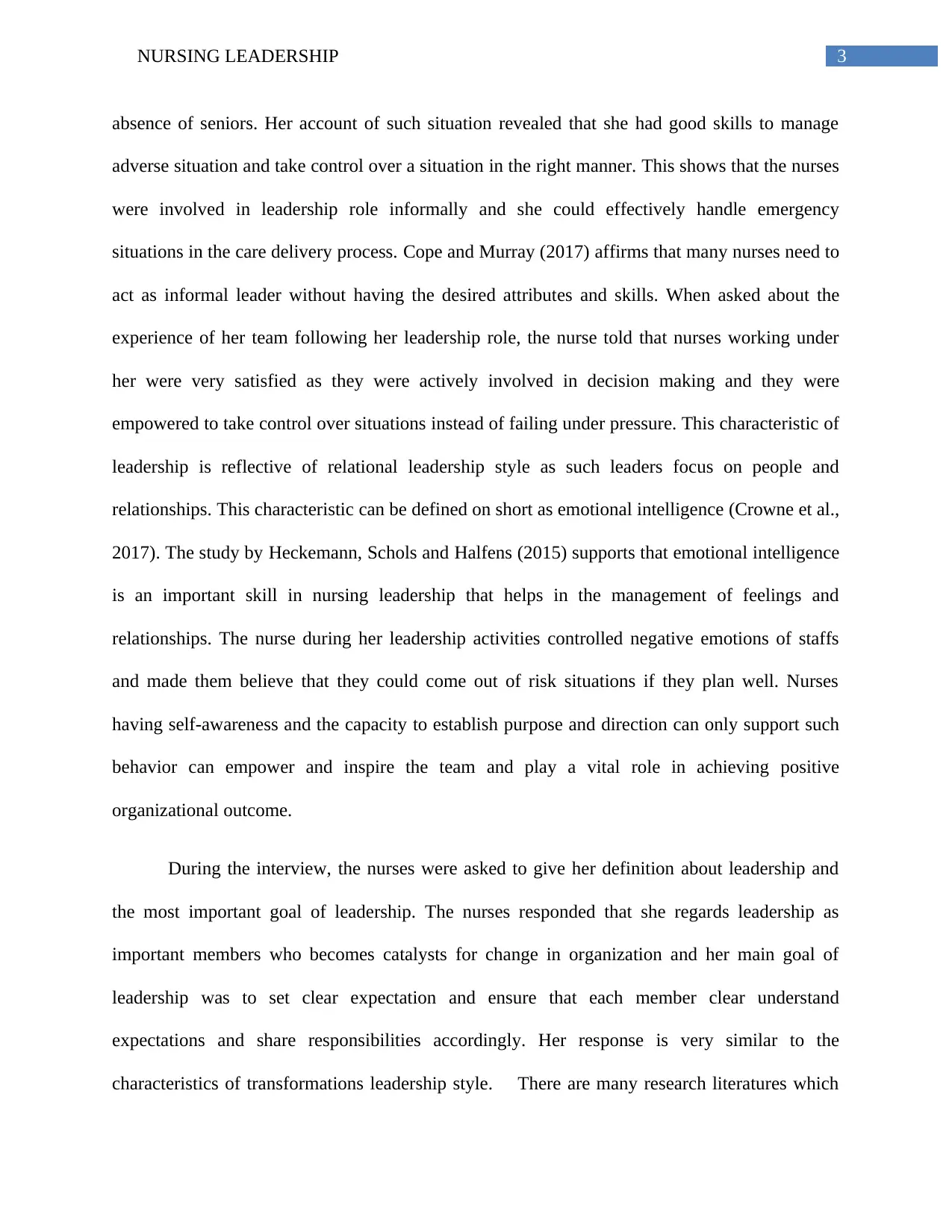
3NURSING LEADERSHIP
absence of seniors. Her account of such situation revealed that she had good skills to manage
adverse situation and take control over a situation in the right manner. This shows that the nurses
were involved in leadership role informally and she could effectively handle emergency
situations in the care delivery process. Cope and Murray (2017) affirms that many nurses need to
act as informal leader without having the desired attributes and skills. When asked about the
experience of her team following her leadership role, the nurse told that nurses working under
her were very satisfied as they were actively involved in decision making and they were
empowered to take control over situations instead of failing under pressure. This characteristic of
leadership is reflective of relational leadership style as such leaders focus on people and
relationships. This characteristic can be defined on short as emotional intelligence (Crowne et al.,
2017). The study by Heckemann, Schols and Halfens (2015) supports that emotional intelligence
is an important skill in nursing leadership that helps in the management of feelings and
relationships. The nurse during her leadership activities controlled negative emotions of staffs
and made them believe that they could come out of risk situations if they plan well. Nurses
having self-awareness and the capacity to establish purpose and direction can only support such
behavior can empower and inspire the team and play a vital role in achieving positive
organizational outcome.
During the interview, the nurses were asked to give her definition about leadership and
the most important goal of leadership. The nurses responded that she regards leadership as
important members who becomes catalysts for change in organization and her main goal of
leadership was to set clear expectation and ensure that each member clear understand
expectations and share responsibilities accordingly. Her response is very similar to the
characteristics of transformations leadership style. There are many research literatures which
absence of seniors. Her account of such situation revealed that she had good skills to manage
adverse situation and take control over a situation in the right manner. This shows that the nurses
were involved in leadership role informally and she could effectively handle emergency
situations in the care delivery process. Cope and Murray (2017) affirms that many nurses need to
act as informal leader without having the desired attributes and skills. When asked about the
experience of her team following her leadership role, the nurse told that nurses working under
her were very satisfied as they were actively involved in decision making and they were
empowered to take control over situations instead of failing under pressure. This characteristic of
leadership is reflective of relational leadership style as such leaders focus on people and
relationships. This characteristic can be defined on short as emotional intelligence (Crowne et al.,
2017). The study by Heckemann, Schols and Halfens (2015) supports that emotional intelligence
is an important skill in nursing leadership that helps in the management of feelings and
relationships. The nurse during her leadership activities controlled negative emotions of staffs
and made them believe that they could come out of risk situations if they plan well. Nurses
having self-awareness and the capacity to establish purpose and direction can only support such
behavior can empower and inspire the team and play a vital role in achieving positive
organizational outcome.
During the interview, the nurses were asked to give her definition about leadership and
the most important goal of leadership. The nurses responded that she regards leadership as
important members who becomes catalysts for change in organization and her main goal of
leadership was to set clear expectation and ensure that each member clear understand
expectations and share responsibilities accordingly. Her response is very similar to the
characteristics of transformations leadership style. There are many research literatures which
Paraphrase This Document
Need a fresh take? Get an instant paraphrase of this document with our AI Paraphraser
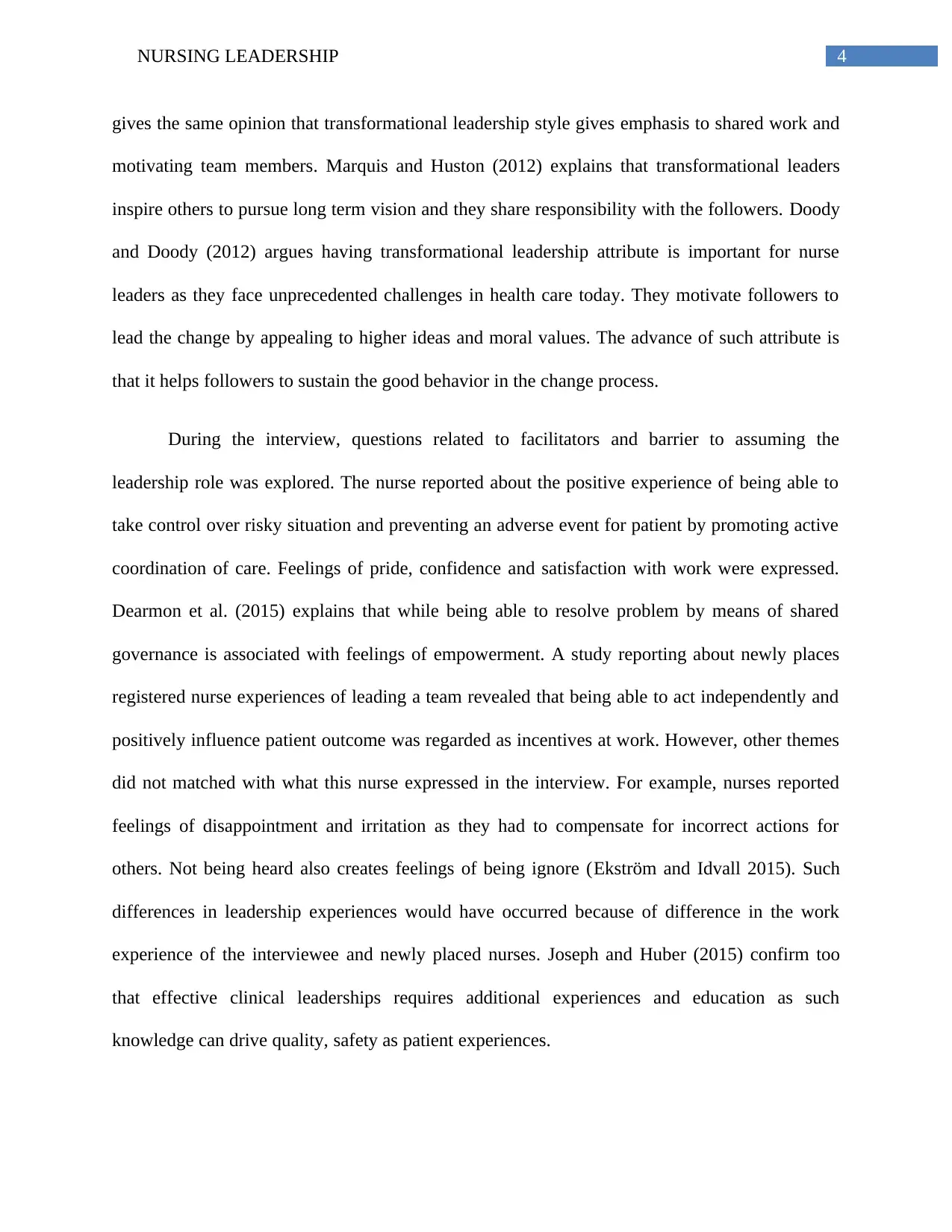
4NURSING LEADERSHIP
gives the same opinion that transformational leadership style gives emphasis to shared work and
motivating team members. Marquis and Huston (2012) explains that transformational leaders
inspire others to pursue long term vision and they share responsibility with the followers. Doody
and Doody (2012) argues having transformational leadership attribute is important for nurse
leaders as they face unprecedented challenges in health care today. They motivate followers to
lead the change by appealing to higher ideas and moral values. The advance of such attribute is
that it helps followers to sustain the good behavior in the change process.
During the interview, questions related to facilitators and barrier to assuming the
leadership role was explored. The nurse reported about the positive experience of being able to
take control over risky situation and preventing an adverse event for patient by promoting active
coordination of care. Feelings of pride, confidence and satisfaction with work were expressed.
Dearmon et al. (2015) explains that while being able to resolve problem by means of shared
governance is associated with feelings of empowerment. A study reporting about newly places
registered nurse experiences of leading a team revealed that being able to act independently and
positively influence patient outcome was regarded as incentives at work. However, other themes
did not matched with what this nurse expressed in the interview. For example, nurses reported
feelings of disappointment and irritation as they had to compensate for incorrect actions for
others. Not being heard also creates feelings of being ignore (Ekström and Idvall 2015). Such
differences in leadership experiences would have occurred because of difference in the work
experience of the interviewee and newly placed nurses. Joseph and Huber (2015) confirm too
that effective clinical leaderships requires additional experiences and education as such
knowledge can drive quality, safety as patient experiences.
gives the same opinion that transformational leadership style gives emphasis to shared work and
motivating team members. Marquis and Huston (2012) explains that transformational leaders
inspire others to pursue long term vision and they share responsibility with the followers. Doody
and Doody (2012) argues having transformational leadership attribute is important for nurse
leaders as they face unprecedented challenges in health care today. They motivate followers to
lead the change by appealing to higher ideas and moral values. The advance of such attribute is
that it helps followers to sustain the good behavior in the change process.
During the interview, questions related to facilitators and barrier to assuming the
leadership role was explored. The nurse reported about the positive experience of being able to
take control over risky situation and preventing an adverse event for patient by promoting active
coordination of care. Feelings of pride, confidence and satisfaction with work were expressed.
Dearmon et al. (2015) explains that while being able to resolve problem by means of shared
governance is associated with feelings of empowerment. A study reporting about newly places
registered nurse experiences of leading a team revealed that being able to act independently and
positively influence patient outcome was regarded as incentives at work. However, other themes
did not matched with what this nurse expressed in the interview. For example, nurses reported
feelings of disappointment and irritation as they had to compensate for incorrect actions for
others. Not being heard also creates feelings of being ignore (Ekström and Idvall 2015). Such
differences in leadership experiences would have occurred because of difference in the work
experience of the interviewee and newly placed nurses. Joseph and Huber (2015) confirm too
that effective clinical leaderships requires additional experiences and education as such
knowledge can drive quality, safety as patient experiences.
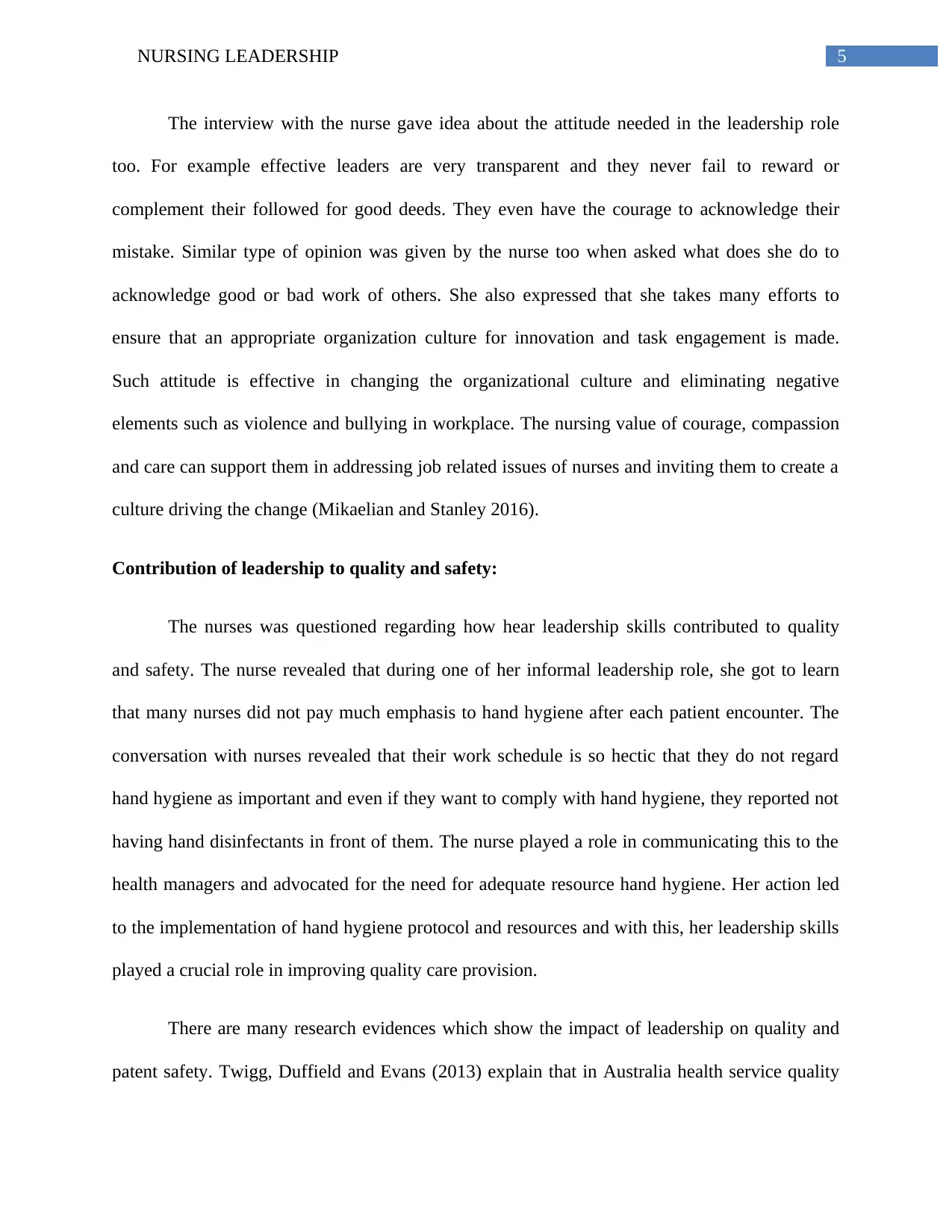
5NURSING LEADERSHIP
The interview with the nurse gave idea about the attitude needed in the leadership role
too. For example effective leaders are very transparent and they never fail to reward or
complement their followed for good deeds. They even have the courage to acknowledge their
mistake. Similar type of opinion was given by the nurse too when asked what does she do to
acknowledge good or bad work of others. She also expressed that she takes many efforts to
ensure that an appropriate organization culture for innovation and task engagement is made.
Such attitude is effective in changing the organizational culture and eliminating negative
elements such as violence and bullying in workplace. The nursing value of courage, compassion
and care can support them in addressing job related issues of nurses and inviting them to create a
culture driving the change (Mikaelian and Stanley 2016).
Contribution of leadership to quality and safety:
The nurses was questioned regarding how hear leadership skills contributed to quality
and safety. The nurse revealed that during one of her informal leadership role, she got to learn
that many nurses did not pay much emphasis to hand hygiene after each patient encounter. The
conversation with nurses revealed that their work schedule is so hectic that they do not regard
hand hygiene as important and even if they want to comply with hand hygiene, they reported not
having hand disinfectants in front of them. The nurse played a role in communicating this to the
health managers and advocated for the need for adequate resource hand hygiene. Her action led
to the implementation of hand hygiene protocol and resources and with this, her leadership skills
played a crucial role in improving quality care provision.
There are many research evidences which show the impact of leadership on quality and
patent safety. Twigg, Duffield and Evans (2013) explain that in Australia health service quality
The interview with the nurse gave idea about the attitude needed in the leadership role
too. For example effective leaders are very transparent and they never fail to reward or
complement their followed for good deeds. They even have the courage to acknowledge their
mistake. Similar type of opinion was given by the nurse too when asked what does she do to
acknowledge good or bad work of others. She also expressed that she takes many efforts to
ensure that an appropriate organization culture for innovation and task engagement is made.
Such attitude is effective in changing the organizational culture and eliminating negative
elements such as violence and bullying in workplace. The nursing value of courage, compassion
and care can support them in addressing job related issues of nurses and inviting them to create a
culture driving the change (Mikaelian and Stanley 2016).
Contribution of leadership to quality and safety:
The nurses was questioned regarding how hear leadership skills contributed to quality
and safety. The nurse revealed that during one of her informal leadership role, she got to learn
that many nurses did not pay much emphasis to hand hygiene after each patient encounter. The
conversation with nurses revealed that their work schedule is so hectic that they do not regard
hand hygiene as important and even if they want to comply with hand hygiene, they reported not
having hand disinfectants in front of them. The nurse played a role in communicating this to the
health managers and advocated for the need for adequate resource hand hygiene. Her action led
to the implementation of hand hygiene protocol and resources and with this, her leadership skills
played a crucial role in improving quality care provision.
There are many research evidences which show the impact of leadership on quality and
patent safety. Twigg, Duffield and Evans (2013) explain that in Australia health service quality
⊘ This is a preview!⊘
Do you want full access?
Subscribe today to unlock all pages.

Trusted by 1+ million students worldwide
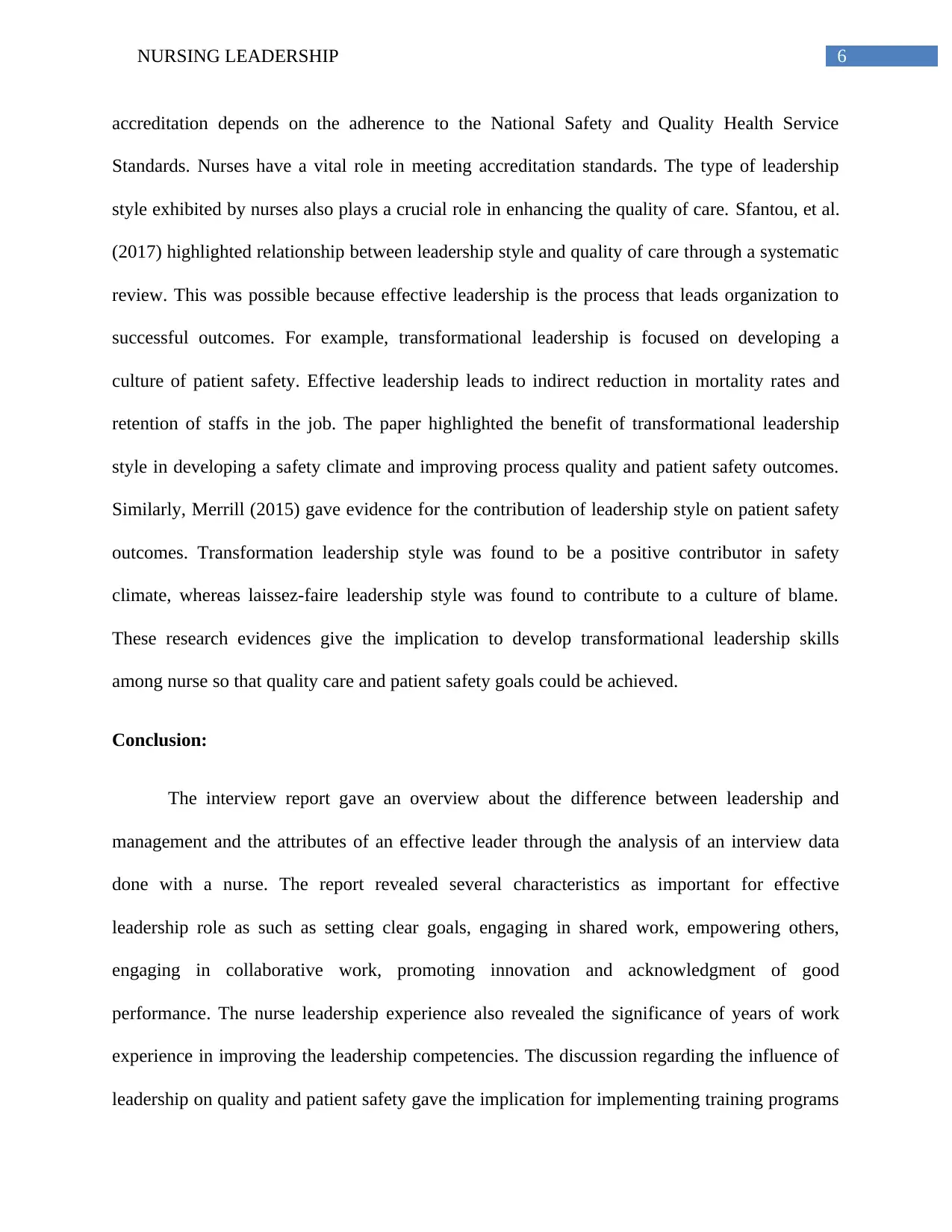
6NURSING LEADERSHIP
accreditation depends on the adherence to the National Safety and Quality Health Service
Standards. Nurses have a vital role in meeting accreditation standards. The type of leadership
style exhibited by nurses also plays a crucial role in enhancing the quality of care. Sfantou, et al.
(2017) highlighted relationship between leadership style and quality of care through a systematic
review. This was possible because effective leadership is the process that leads organization to
successful outcomes. For example, transformational leadership is focused on developing a
culture of patient safety. Effective leadership leads to indirect reduction in mortality rates and
retention of staffs in the job. The paper highlighted the benefit of transformational leadership
style in developing a safety climate and improving process quality and patient safety outcomes.
Similarly, Merrill (2015) gave evidence for the contribution of leadership style on patient safety
outcomes. Transformation leadership style was found to be a positive contributor in safety
climate, whereas laissez-faire leadership style was found to contribute to a culture of blame.
These research evidences give the implication to develop transformational leadership skills
among nurse so that quality care and patient safety goals could be achieved.
Conclusion:
The interview report gave an overview about the difference between leadership and
management and the attributes of an effective leader through the analysis of an interview data
done with a nurse. The report revealed several characteristics as important for effective
leadership role as such as setting clear goals, engaging in shared work, empowering others,
engaging in collaborative work, promoting innovation and acknowledgment of good
performance. The nurse leadership experience also revealed the significance of years of work
experience in improving the leadership competencies. The discussion regarding the influence of
leadership on quality and patient safety gave the implication for implementing training programs
accreditation depends on the adherence to the National Safety and Quality Health Service
Standards. Nurses have a vital role in meeting accreditation standards. The type of leadership
style exhibited by nurses also plays a crucial role in enhancing the quality of care. Sfantou, et al.
(2017) highlighted relationship between leadership style and quality of care through a systematic
review. This was possible because effective leadership is the process that leads organization to
successful outcomes. For example, transformational leadership is focused on developing a
culture of patient safety. Effective leadership leads to indirect reduction in mortality rates and
retention of staffs in the job. The paper highlighted the benefit of transformational leadership
style in developing a safety climate and improving process quality and patient safety outcomes.
Similarly, Merrill (2015) gave evidence for the contribution of leadership style on patient safety
outcomes. Transformation leadership style was found to be a positive contributor in safety
climate, whereas laissez-faire leadership style was found to contribute to a culture of blame.
These research evidences give the implication to develop transformational leadership skills
among nurse so that quality care and patient safety goals could be achieved.
Conclusion:
The interview report gave an overview about the difference between leadership and
management and the attributes of an effective leader through the analysis of an interview data
done with a nurse. The report revealed several characteristics as important for effective
leadership role as such as setting clear goals, engaging in shared work, empowering others,
engaging in collaborative work, promoting innovation and acknowledgment of good
performance. The nurse leadership experience also revealed the significance of years of work
experience in improving the leadership competencies. The discussion regarding the influence of
leadership on quality and patient safety gave the implication for implementing training programs
Paraphrase This Document
Need a fresh take? Get an instant paraphrase of this document with our AI Paraphraser
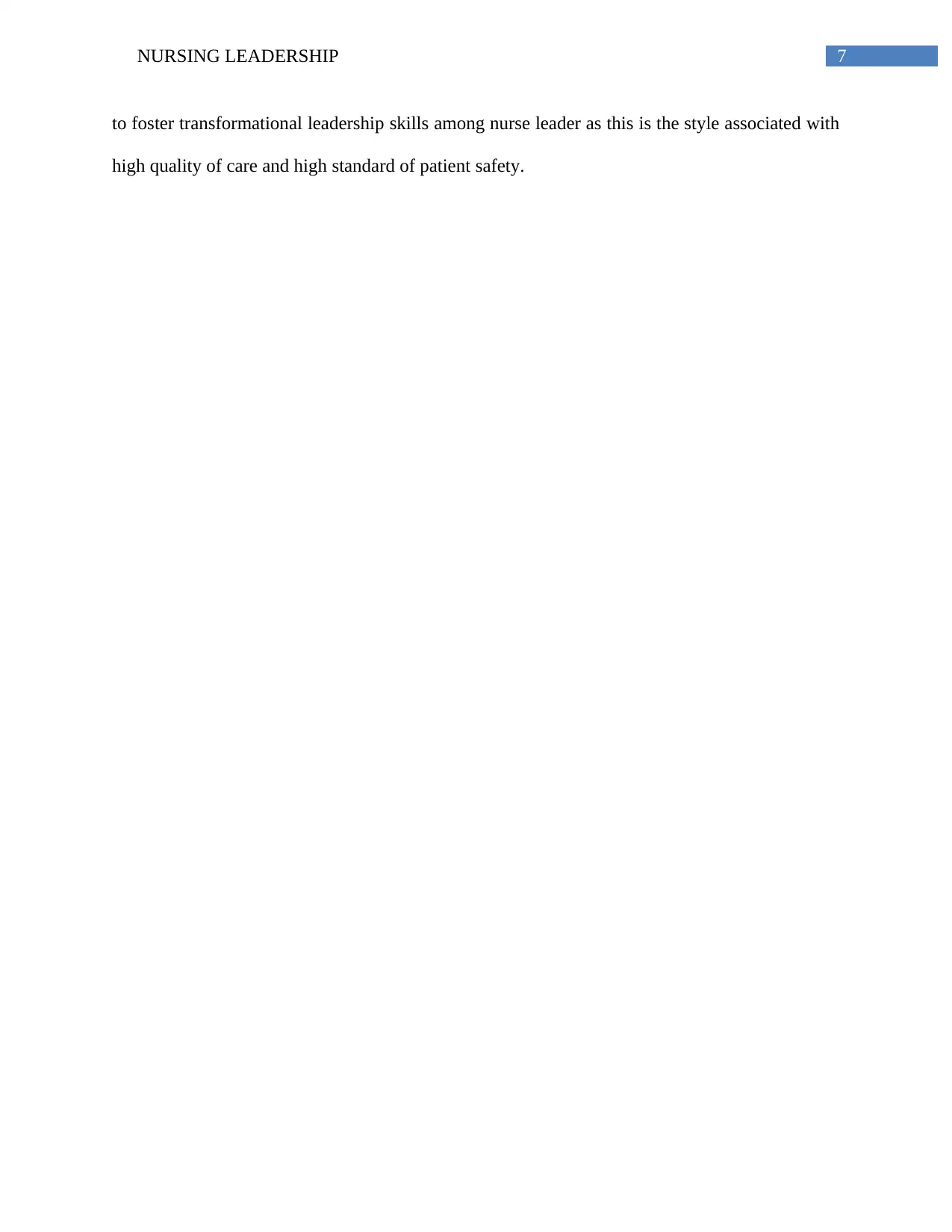
7NURSING LEADERSHIP
to foster transformational leadership skills among nurse leader as this is the style associated with
high quality of care and high standard of patient safety.
to foster transformational leadership skills among nurse leader as this is the style associated with
high quality of care and high standard of patient safety.
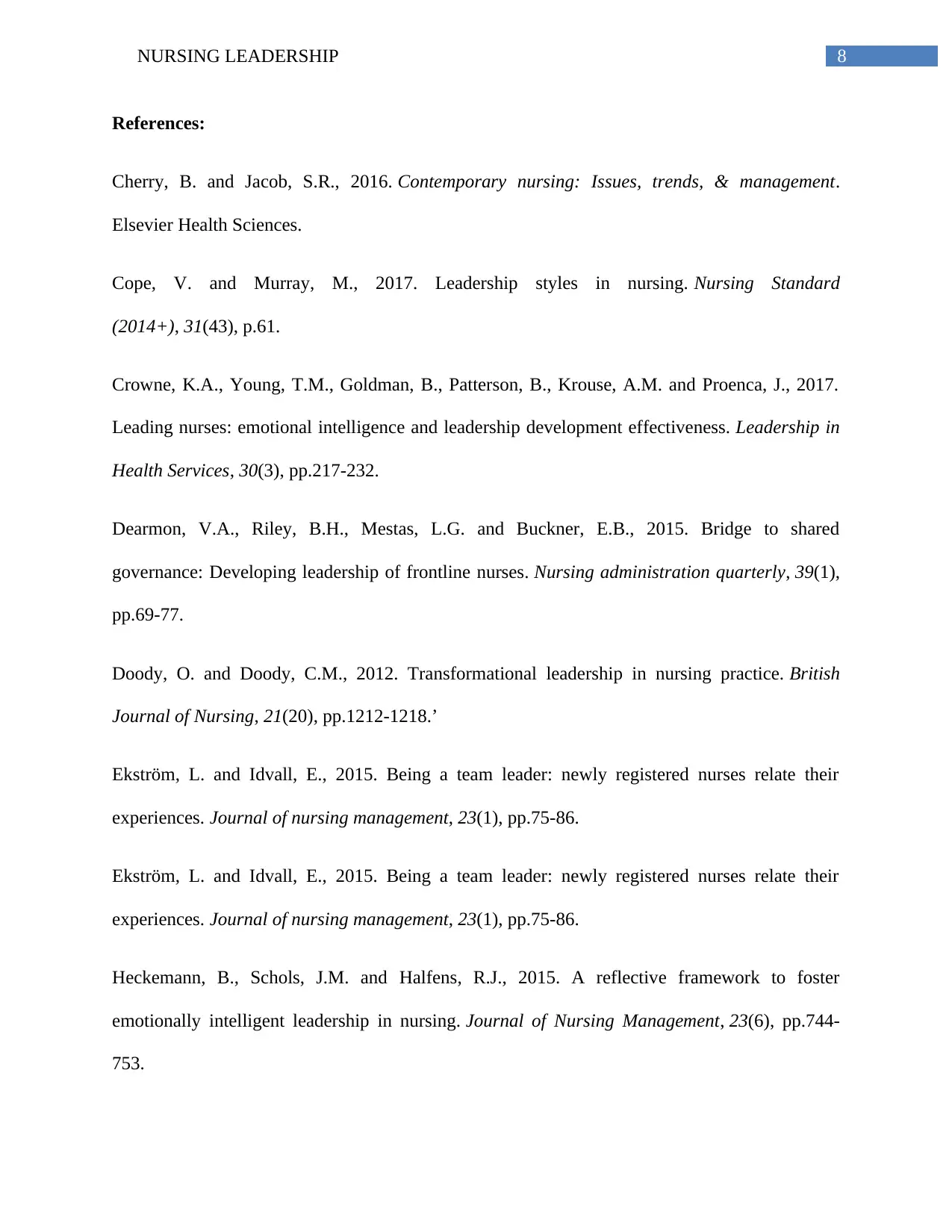
8NURSING LEADERSHIP
References:
Cherry, B. and Jacob, S.R., 2016. Contemporary nursing: Issues, trends, & management.
Elsevier Health Sciences.
Cope, V. and Murray, M., 2017. Leadership styles in nursing. Nursing Standard
(2014+), 31(43), p.61.
Crowne, K.A., Young, T.M., Goldman, B., Patterson, B., Krouse, A.M. and Proenca, J., 2017.
Leading nurses: emotional intelligence and leadership development effectiveness. Leadership in
Health Services, 30(3), pp.217-232.
Dearmon, V.A., Riley, B.H., Mestas, L.G. and Buckner, E.B., 2015. Bridge to shared
governance: Developing leadership of frontline nurses. Nursing administration quarterly, 39(1),
pp.69-77.
Doody, O. and Doody, C.M., 2012. Transformational leadership in nursing practice. British
Journal of Nursing, 21(20), pp.1212-1218.’
Ekström, L. and Idvall, E., 2015. Being a team leader: newly registered nurses relate their
experiences. Journal of nursing management, 23(1), pp.75-86.
Ekström, L. and Idvall, E., 2015. Being a team leader: newly registered nurses relate their
experiences. Journal of nursing management, 23(1), pp.75-86.
Heckemann, B., Schols, J.M. and Halfens, R.J., 2015. A reflective framework to foster
emotionally intelligent leadership in nursing. Journal of Nursing Management, 23(6), pp.744-
753.
References:
Cherry, B. and Jacob, S.R., 2016. Contemporary nursing: Issues, trends, & management.
Elsevier Health Sciences.
Cope, V. and Murray, M., 2017. Leadership styles in nursing. Nursing Standard
(2014+), 31(43), p.61.
Crowne, K.A., Young, T.M., Goldman, B., Patterson, B., Krouse, A.M. and Proenca, J., 2017.
Leading nurses: emotional intelligence and leadership development effectiveness. Leadership in
Health Services, 30(3), pp.217-232.
Dearmon, V.A., Riley, B.H., Mestas, L.G. and Buckner, E.B., 2015. Bridge to shared
governance: Developing leadership of frontline nurses. Nursing administration quarterly, 39(1),
pp.69-77.
Doody, O. and Doody, C.M., 2012. Transformational leadership in nursing practice. British
Journal of Nursing, 21(20), pp.1212-1218.’
Ekström, L. and Idvall, E., 2015. Being a team leader: newly registered nurses relate their
experiences. Journal of nursing management, 23(1), pp.75-86.
Ekström, L. and Idvall, E., 2015. Being a team leader: newly registered nurses relate their
experiences. Journal of nursing management, 23(1), pp.75-86.
Heckemann, B., Schols, J.M. and Halfens, R.J., 2015. A reflective framework to foster
emotionally intelligent leadership in nursing. Journal of Nursing Management, 23(6), pp.744-
753.
⊘ This is a preview!⊘
Do you want full access?
Subscribe today to unlock all pages.

Trusted by 1+ million students worldwide
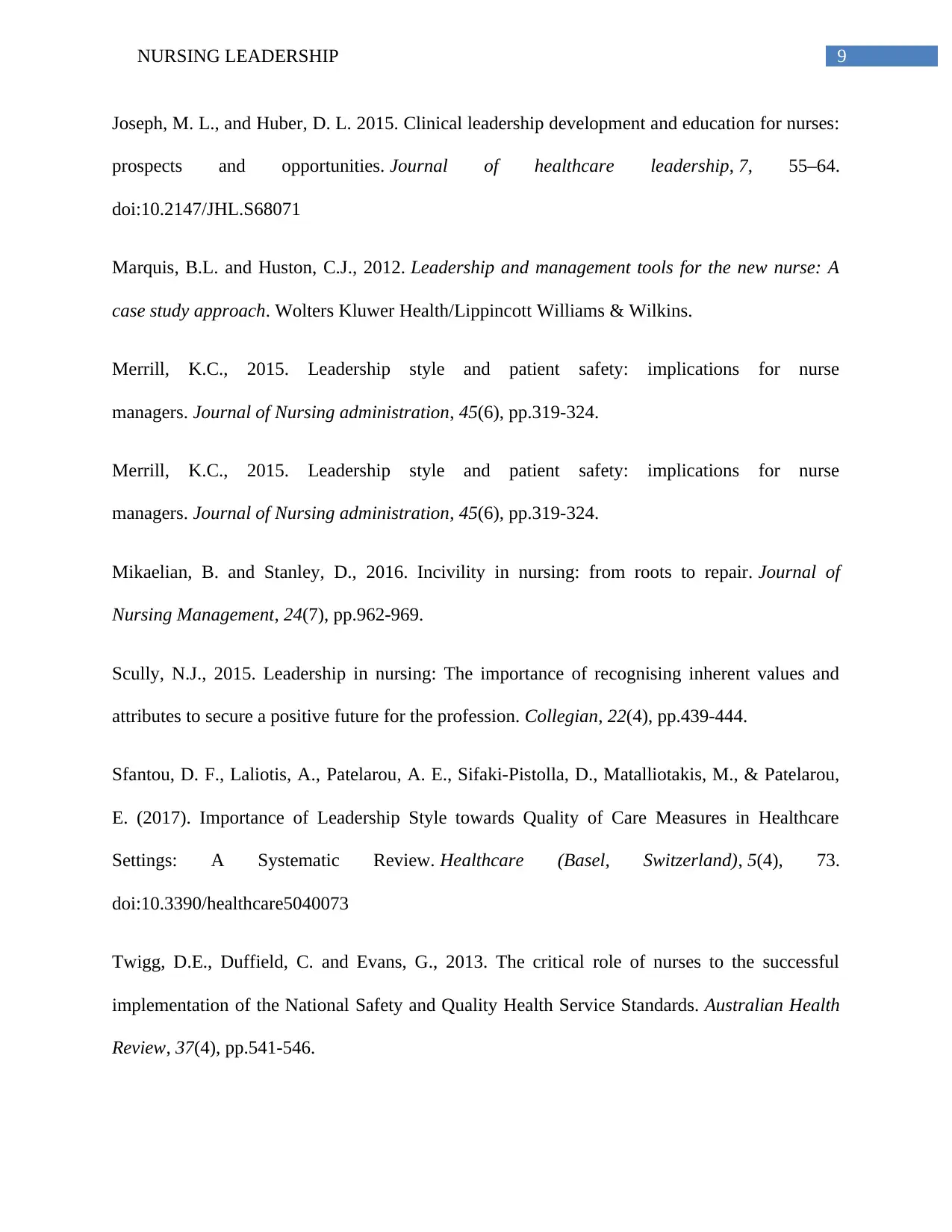
9NURSING LEADERSHIP
Joseph, M. L., and Huber, D. L. 2015. Clinical leadership development and education for nurses:
prospects and opportunities. Journal of healthcare leadership, 7, 55–64.
doi:10.2147/JHL.S68071
Marquis, B.L. and Huston, C.J., 2012. Leadership and management tools for the new nurse: A
case study approach. Wolters Kluwer Health/Lippincott Williams & Wilkins.
Merrill, K.C., 2015. Leadership style and patient safety: implications for nurse
managers. Journal of Nursing administration, 45(6), pp.319-324.
Merrill, K.C., 2015. Leadership style and patient safety: implications for nurse
managers. Journal of Nursing administration, 45(6), pp.319-324.
Mikaelian, B. and Stanley, D., 2016. Incivility in nursing: from roots to repair. Journal of
Nursing Management, 24(7), pp.962-969.
Scully, N.J., 2015. Leadership in nursing: The importance of recognising inherent values and
attributes to secure a positive future for the profession. Collegian, 22(4), pp.439-444.
Sfantou, D. F., Laliotis, A., Patelarou, A. E., Sifaki-Pistolla, D., Matalliotakis, M., & Patelarou,
E. (2017). Importance of Leadership Style towards Quality of Care Measures in Healthcare
Settings: A Systematic Review. Healthcare (Basel, Switzerland), 5(4), 73.
doi:10.3390/healthcare5040073
Twigg, D.E., Duffield, C. and Evans, G., 2013. The critical role of nurses to the successful
implementation of the National Safety and Quality Health Service Standards. Australian Health
Review, 37(4), pp.541-546.
Joseph, M. L., and Huber, D. L. 2015. Clinical leadership development and education for nurses:
prospects and opportunities. Journal of healthcare leadership, 7, 55–64.
doi:10.2147/JHL.S68071
Marquis, B.L. and Huston, C.J., 2012. Leadership and management tools for the new nurse: A
case study approach. Wolters Kluwer Health/Lippincott Williams & Wilkins.
Merrill, K.C., 2015. Leadership style and patient safety: implications for nurse
managers. Journal of Nursing administration, 45(6), pp.319-324.
Merrill, K.C., 2015. Leadership style and patient safety: implications for nurse
managers. Journal of Nursing administration, 45(6), pp.319-324.
Mikaelian, B. and Stanley, D., 2016. Incivility in nursing: from roots to repair. Journal of
Nursing Management, 24(7), pp.962-969.
Scully, N.J., 2015. Leadership in nursing: The importance of recognising inherent values and
attributes to secure a positive future for the profession. Collegian, 22(4), pp.439-444.
Sfantou, D. F., Laliotis, A., Patelarou, A. E., Sifaki-Pistolla, D., Matalliotakis, M., & Patelarou,
E. (2017). Importance of Leadership Style towards Quality of Care Measures in Healthcare
Settings: A Systematic Review. Healthcare (Basel, Switzerland), 5(4), 73.
doi:10.3390/healthcare5040073
Twigg, D.E., Duffield, C. and Evans, G., 2013. The critical role of nurses to the successful
implementation of the National Safety and Quality Health Service Standards. Australian Health
Review, 37(4), pp.541-546.
1 out of 10
Related Documents
Your All-in-One AI-Powered Toolkit for Academic Success.
+13062052269
info@desklib.com
Available 24*7 on WhatsApp / Email
![[object Object]](/_next/static/media/star-bottom.7253800d.svg)
Unlock your academic potential
Copyright © 2020–2025 A2Z Services. All Rights Reserved. Developed and managed by ZUCOL.





